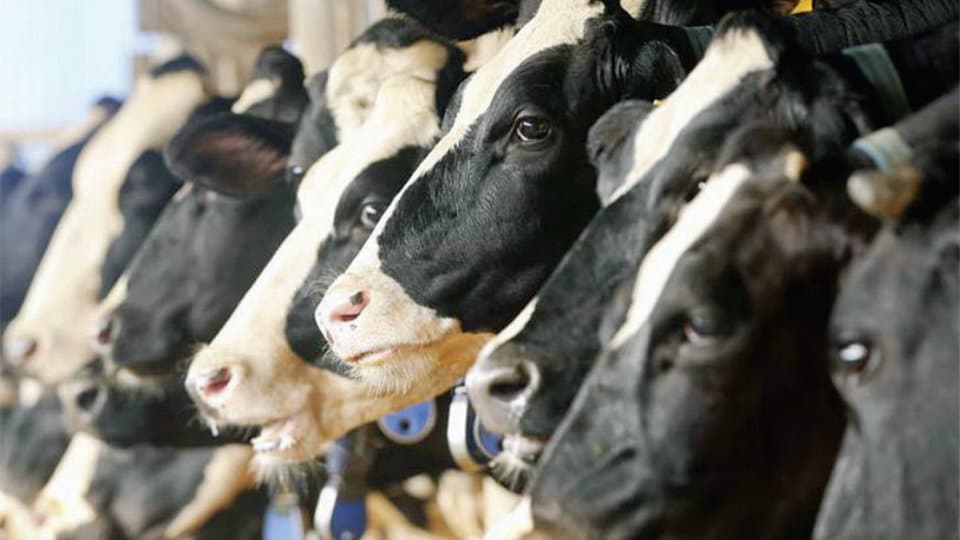In this week’s Pet Talk, Maneka tells how one’s diet and lifestyle impact cows in India and more
By Maneka Gandhi
How can we prevent and treat ketosis in cows?
Ketosis is a metabolic disorder that occurs in cattle when energy demands (example: High milk production) exceed energy intake and result in a negative energy balance. Ketosis occurs when the body does not have sufficient access to its primary fuel source, glucose. Ketosis describes a condition where fat stores are broken down to produce energy, which also produces ketones, a type of acid. Ketotic cows often have low blood glucose (blood sugar) concentrations.
Ketosis can be prevented by managing feed and by paying attention to cow behaviour and adverse weather conditions. Ensure feed supply meets feed demand.
Do not make your cows pregnant more than once in two years. Ensure cows have adequate feed allocated post-calving, taking into account weather conditions. Avoid sudden feed shortages, if possible. Use supplementary feeds if there is a pasture deficit. If feed restrictions are unavoidable, introduce the feed deficit gradually, and only milk them once a day to improve energy balance. Ensure any silage fed is of high quality and stored correctly.
Ketotic cows often have low blood glucose (blood sugar) concentrations. Bad Breath. Weight Loss, Increased Ketones in the Blood, Breath or Urine, low appetite, fatigue.
Using propylene glycol may be useful in preventing ketosis. The initial aim of treatment is to restore the lack of glucose in the body. Bolus IV administration of 500 ML of 50% dextrose solution is a common therapy.
What to do once I have treated my cattle for lice?
The most important thing to remember, when treating your cows for lice with pesticides, is to re-treat the cows 20 days after the first treatment. Many pesticides only kill the hatched-out insects. Cows will be host to unhatched eggs, and those eggs will hatch in just a few weeks after the original treatment. The most optimal treatment is given after 20-days, as treating 20 days later will kill most of the lice on the cows. Do not miss any cows as you treat. A single cow could be a lice reservoir that re-infects all of your cattle with lice.
Do external changes confuse cows?
Cows recognise people from the shape and colour of their clothing as well. If your cow is acting differently than usual, ask yourself if you are dressed differently from normal. If so, your cow is reacting like she would if a total stranger came to try to handle her. When you know how your cow perceives the world, you will be able to work within your cow’s comfort zone and keep her calmer. Calm cows mean that everything will be much easier.
Cows are lovely animals, but they act out when they don’t understand what is going on. By respecting their limitations, you can make things easy for yourself and the cow.
Do cows like being touched?
If you have never given a cow a belly rub, you should. Cows love to be petted, stroked and scratched behind the ears. Even cows who have been mistreated or abused in the past can heal over time, by forgiving and learning to trust people again.
How do cows experience odours?
Cows not only experience odours with their noses but they also have one other organ, the Jacobson’s organ in the roofs of their mouths. Sometimes, when a cow is smelling something, it will raise its head and curl back its lips with its mouth open. It looks kind of strange, but the cow is actually using the Jacobson’s organ to perceive an odour.
How does a cow see the world?
In order to understand your cows with ease and confidence, you should learn about how cattle see the world. While cows perceive the world with all five of their senses, they rely greatly on their vision, especially when they are nervous. They have a Panoramic, Horizontal Vision, but with limitations. They have eyes located on the sides of their heads, giving them a wide field of view of at least 330 degrees.
However, their binocular vision is limited to about 30- 50 degrees and they have a blind spot directly behind them. They have good visual acuity, but their accommodation abilities are not as well-developed as those of humans. Cows are dichromatic and are able to distinguish among long wavelength colours (red, orange and yellow) better than shorter wavelengths (blue, green).
How does one’s diet and lifestyle impact cows in India? Is there a correlation between drinking milk and wearing leather-made products in India?
Yes, there is a strong correlation between drinking milk and wearing leather-made products in India. Cows provide the bulk of leather used, while goats, pigs, and sheep supplement this to meet basic demand.
Of the leather from cows, the majority is taken from those who are slaughtered for their meat, or from dairy cows no longer producing enough milk to remain profitable.
Cows, used by the dairy industry, are typically killed after about three years, because their bodies wear out from constantly being pregnant or lactating. A dairy-industry study found that by the time they are killed, nearly 50 percent of cows are lame because of standing on flooring with filth in intensive confinement.
Cows’ bodies are often turned into soup, food for dogs and cats, or ground beef, because they are too “spent” to be used for anything else. Hence, one’s diet and lifestyle greatly impacts cows in India because they are slaughtered daily for people’s purposes.








Recent Comments